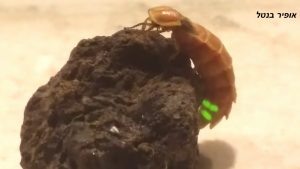It probably began years ago, because they are gradually disappearing. And it’s not just about the fireflies – their disappearance is part of a dramatic decrease in the diversity of insects around the world, particularly flying insects.
What are fireflies? Fireflies are a family of beetles numbering more than two thousand species, including eight species that live in Israel. Most (but not all) produce light, which is used mainly for creating signals that enable males and females to meet for reproduction.

A female lights up. Photo: Ofir Bental
There are three main factors that severely impact firefly populations worldwide. Firstly, habitat fragmentation and loss; this factor has a great effect on fireflies in Israel, since the females of all the firefly species living in Israel are wingless. In other words, they are limited in their ability to go from place to place to find a mate. Thus, construction on areas that previously supported fireflies can drive entire populations to extinction.
The second factor is artificial night lighting, which creates light pollution. Light pollution affects many species of animals, particularly fireflies. Since both males and females are nocturnal, and rely on light signals to locate each other, night lighting makes it difficult for them to meet up and thus their reproduction is negatively impacted.
Another factor is pesticides, which impact fireflies at both the larval and adult stages. Most pesticides for insects (i.e., insecticides) are not specific, and don’t affect only the “pest” species. Currently, we can safely say that the use of insecticides also impacts fireflies, but further research is required to determine which substances affect them and what is the exact mechanism of action.

Firefly. Photo: Oz Rittner
The first comprehensive study on fireflies in Israel has been conducted over the last two years by Ella Fishman, a master’s student in the School of Zoology at Tel Aviv University and the Steinhardt Museum of Natural History, supervised by Dr. Netta Dorchin. The aim of the study is to determine which firefly species live in Israel, document their distribution range and experimentally assess how light pollution affects their behavior.
To assist the documentation of the distribution of fireflies (Lampyridae) in Israel, a survey was published one year ago, in collaboration with the Society for Protection of Nature in Israel; in this survey, anyone observing a firefly (larva or adult) is asked to report it on the website. The preliminary results of the survey are encouraging, and indicate a broad distribution of fireflies in the Mediterranean region of Israel, from Be’er Sheva in the south to Metulla in the north, including urban areas. Another encourage finding is the fact that firefly larvae are being observed in gardens, indicating that even in the event of habitat loss due to construction of new neighborhoods, certain gardens can serve as suitable habitats for fireflies. The many reports that have been received (1,640 to date) teach us about the active season for fireflies in Israel: the larvae are active throughout the year, while adults of different species are active from late March, lighting up our nights until September.
Have you seen fireflies? We invite you to participate in the survey. Report your observations on the website (hebrew).






